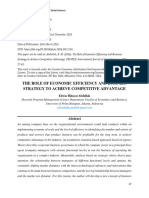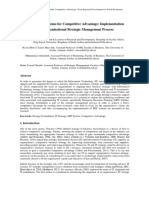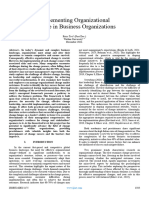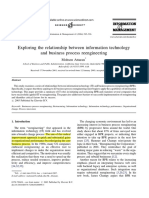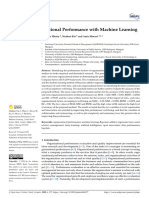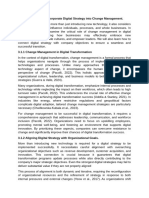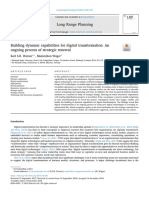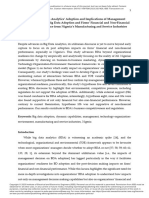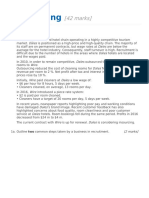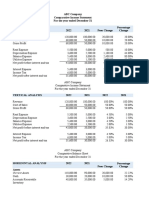Business Process Reengineering - A Review On Chang
Business Process Reengineering - A Review On Chang
Uploaded by
sitiasmirantiCopyright:
Available Formats
Business Process Reengineering - A Review On Chang
Business Process Reengineering - A Review On Chang
Uploaded by
sitiasmirantiOriginal Title
Copyright
Available Formats
Share this document
Did you find this document useful?
Is this content inappropriate?
Copyright:
Available Formats
Business Process Reengineering - A Review On Chang
Business Process Reengineering - A Review On Chang
Uploaded by
sitiasmirantiCopyright:
Available Formats
REVIEW ARTICLE
Management Insight, Vol. XVII , No. 1; 2021 Print ISSN: 0973-936X; Online ISSN: 2456-0936
Business Process Reengineering – A Review on Change
Management
Prashant Singh1, Pushpa Kataria2
1
Assistant Professor, 2Associate Professor
1&2
Doon Business School, Dehardun, India.
Abstract
With today's highly competitive and rapidly changing world economic marketplace, firms must adopt business process reengineering to
sustain their competitive advantages and increase profitability. BPR is one of the most popular ongoing change management theories as a
solution for firms to improve their performance significantly, upraise their efficiencies, and gain a competitive advantage in this
constantly developing and changing world. BPR usually leads to essential organizational changes in terms of structure and management
processes. This paper aims to explore the change management process through BPR implementation in Radiant Optoelectronics
Company. At the same time, focusing on six interventions, including Open systems planning, Trans-organizational development (TD),
Business process reengineering (BPR), Business Restructuring, Work Redesign, and Socio-technical Systems Approach (STS). Each
intervention is accompanied by its definitions, advantages and disadvantages, and comparison and contrast with other interventions.
These interventions differ from each other primarily in terms of IT innovation, communication environment, and application in product
design and performance. This report recommends BPR as the best intervention for Radiant Company to accomplish its goals because it
emphasizes cost reduction, product and service quality, and organizational system speed. Besides, there is evidence that companies that
implement BPR enjoy significant benefits in improved customer satisfaction, productivity, and profitability. However, this study suggests
that the company must be keen on this strategy since it is time-consuming and may harm people's jobs if proper plans are not done before
implementation. Other issues that the company might experience due to poor planning include lack of sustained management
commitment and leadership, unrealistic scope and expectations, resistance to change, and higher demands.
Keywords: BPR, Change Management, Performance, restructuring, organizational systems
Management Insight (2021). DOI: 110.21844/mijia.17.1.7
Introduction Corresponding Author: Prashant Singh, Lecturer, Assistant Professor,
Doon Business School, Dehradun, India.,
Currently, the world's economic marketplace is rapidly Email: prashant.singhuq@gmail.com
How to cite this article: Singh P., Kataria P.,. (2021). Business Process
changing and highly competitive, that organizations Reengineering – A Review on Change Management. Management
need to give up outdated ways of doing business and Insight, 17(1) 50-55
adjust to changes in their environment. Business Source of support: Nil
Conflict of interest: None
Process Reengineering (BPR) is one of the most popular Received: 02.06.2021; Accepted: 24.06.2021; Published: 14.07.2021
change management approaches which has attracted
significant attention from practitioners and
academicians and has become commonplace among Following the continuous expansion in the application
companies. This study is based on Radiant Opto- of liquid crystal and the consistent development and
electronics Company, a multinational Opto-electronics innovation of new technologies, the backlight module
company established in July 1995. The company's head industry has entered into an inter-regional competition
office is located in Kaohsiung Export Processing Zone from regional competition after more than ten years of
in Taiwan. Radiant Opto-electronics is the first development. In order to prepare to meet more powerful
professional R&D and manufacturer of backlight and high-class competitors, customers' high
modules that focus on designing, manufacturing, expectations, and demands in the future, Radiant is
assembling, and marketing backlight modules. implementing BPR to enhance its global business
Business Process Reengineering – A Review on Change Management
blueprint and outstanding operating performances and Ramdeo, 2020). According to Singh and Ramdeo, many
to cultivate talented people for crucial long-term organizations nowadays adopt the Trans-organizational
development in national, regional, and global markets development strategy to provide additional resources for
(Radiant, 2009). research and development. Applying diverse
professionalism to solve complex tasks and issues
Literature Review spreads new risks, helps organizations attain economies
of scale, and access more diverse markets can be the
Open systems planning other options.
Generally, an open system is a framework that often Boje (1979) described TD as collective storytelling
shares feedback with its external environment. In other shaped and co-constructed by the participants in an
words, it is a group of sections adding up to a whole that organization. Each stakeholder expresses their
interacts with their environment through efforts, collective storytelling's points of view, whether
materials, and information exchange, aiming to renew problem-based, issue-based, solution-based, or just
and grow the organizational system (Jaskyte, 2020). fantasy based on the meaning. The main advantages of
Open system planning (OSP) improves individual and TD are that when people communicate their stories, they
organizational effectiveness by enhancing interactions convoke to interact and form everyday experiences,
between the organizational systems and their external form networks for actions. Change develops around
environment. OSP is usually ideal for organizations their collective storytelling (Boje, 1982). However,
seeking a more flexible environment for systems research has shown different impacts on learning and
integration and development. It provides improved knowledge interwork during trans-organizational
utilization of information technology and helps product design and innovation performance (Millar,
organizations be more adaptive to changes (Jaskyte, Demaid & Quintas, 1997). Therefore, TD is similar to
2020). Besides, OSP increases organizational the socio-technical system approach and differs from
performance and functionality through cost reduction work redesign and business restructuring.
using new technology (Martin & Hough, 1992).
However, Chau (1997) has found a significant failed Business process reengineering (BPR)
relationship between these benefits and adoption that is
quite different from other IT innovations studies. Like BPR is the process of redesigning or changing the
the socio-technical system approach and work redesign, prevailing business procedures (Lizano-Mora et al.,
OSP focuses on the communication environment and IT 2021). Lizano-Mora et al. argue that an organization is a
innovation. simple collection of roles and a complete operating
system with very independent sections that work for the
Trans-organizational Development organization's good. In most cases, BPR is considered an
organizational development project led by a project
Trans-organizational development (TD) refers to a team that analyses and implements the required changes.
development strategy for organizations seeking efficacy Lizano-Mora et al. also suggest that BPR creates a vision
and achievement of set goals such as improved financial for businesses and offers a business goal after business
performance, customer satisfaction, and the power to and management redesigning. Ongeri, Magutu, and
adjust to new changes. The core intention of TD is to Litondo (2020) regard information technology as the
facilitate the effectiveness of an organization through core consideration in BPR for a company that seeks to
the application of exceptional proficiencies and make radical changes. Ongeri, Magutu, and Litondo
resources such as innovative products (Singh & further argue that IT utilization in BPR challenges the
Ramdeo, 2020). Furthermore, TD assists organizations traditional notion of discontinuous recognizing or
to develop and maintain multi-organization thinking and deviating from the outdated rules and
connections, transcend the perspective of single fundamental assumptions underlying organizational
organizations and deal with the issues and needs of all operations. They explain BPR stating that IT is a core
organizations or stakeholders involved (Singh & resource that ensures critical changes in marketing,
Management Insight Vol.17, No.1; 2021 51
Business Process Reengineering – A Review on Change Management
competitive behavior, and customer service and helps products or services' improvement; failure to emphasize
organizations attain competitive advantages. the company's strategy hence cannot lead to radical
improvement (Gupta & Rohe, 1997). BPR can be
The concept and purpose of BPR are to trace its roots defined as the process of a set of connected actions to
back to management and to make all processes the best take an input and transform it into an output. The
(Goksoy, Ozsoy, & Vayvay, 2012). However, the transformation should also add value to the input, thus
foundation of BPR is the growth of the company producing an output that is beneficial to the
Development and
Objectives
Ongoing Continuous
Improvement Understand Exiting
1 Processes
8
2
Evaluate the 7 BUSINESS
New Process PROCESS Identify Process
RE-ENGINEERING for R-design
3
6
4
Make New Process
Operational 5 Identify Change
Levers
Implement the
New Process
Source: Vakola et al. (1998)
Figure1 : The process of BPR
customers (Johansson et al., 1993). However, BPR is may also entail reconfigurations or simple changes such
very time-consuming and with high-risk and high as segregating, adding, dissolving, or transferring
rewards. Some reasons for failing to carry out BPR are business units that may have little or no impact on the
resistance to change, lack of preparation, incorrect deeper structure (Ongeri, Magutu & Litondo, 2020).
strategic mission and vision, and high expectations too Ongeri, Magutu, and Litondo explain that successful
early (Goksoy, Ozsoy&Vayvay, 2012). Unlike business business restructuring requires debtors to make
restructuring that focuses more on downsizing, BPR fundamental and strategic changes to the organization
focuses on innovating and improving organizational and have the required resources to carry out the
performance. significant upheavals.
Business Restructuring Business restructuring is usually essential when firms
encounter changing business environment,
Business Restructuring, often initiated as a rescue tool, unsatisfactory operating performance and stock returns,
mainly when firms are dealing with negative earning, financial distress, economic recession, and corporate
which forces organizations to operate things such as a disciplinary events (Lin, Zu-Hsu & Gibbs, 2008).
t a k e o v e r, m e rg e r s , d i v e s t i t u r e s , fi n a n c i a l Although it is considered as a rescue tool to save firms,
recapitalizations, going-private transactions, spin-offs, there are still some negative impacts. For example, cost
and splits-up (Weston, Jawien, Levitas, 1998; Lin, Zu- control is often the first step to return to profitability.
Hsu, & Gibbs, 2008). When a company undergoes Reducing labor costs, production costs, selling and
business restructuring, it organizes its system in a way administrative expenses, R&D expenditures, and
that improves its functioning. The business restructuring financing costs are standard measures of corporate
Management Insight Vol.17, No.1; 2021 52
Business Process Reengineering – A Review on Change Management
restructurings (Lin, Zu-Hsu & Gibbs, 2008). In and technical factors that affect the operation and
addition, firms will lose their talent, and organizational utilization of computer-based systems. Failure to do so
knowledge will outflow. Nevertheless, compared to can alter the ability of the systems to make the desired
other interventions, business restructuring saves the contribution to the organizational goals.
firm from financial loss and deficit, unlike others, by
mainly focusing on organizational improvement and The benefits of STS are that it enables the firms to
innovation. redesign job-related processes and holds jobs in
organizations that can be conceived in terms of social
Job or work redesign and technical subsystems. On the one hand, the social
subsystem comprises the profile and expectations of
Job or work redesign refers to activities that involve the employees, patterns of supervisory-subordinate
alternation of specific jobs to improve both relationships, interpersonal relationships of employees,
productivities and benefit both employees' work and the natural interaction of subgroups within the
experiences and their employers (Hackman, 1980; population. On the other hand, an organization's
Hornung et al., 2010). Further benefits include more technical subsystem involves tools, work techniques and
intrinsically satisfying work and greater wellbeing for procedures, skills, knowledge, and devices used by the
employees, along with gains in employee attendance, social subsystem employees to complete the
retention, performance, and productivity that organization's tasks (Ghosh & Sahney, 2011).
employers value. Moreover, this positive work- Nevertheless, according to Ghosh and Sahney (2011),
outcome will lead to employees' initiative, STS has significantly influenced managerial retention.
organizational commitment, empowerment, and Comparing STS to others, this intervention focuses
increasing work engagement, reducing work stressors more on internal communication between social aspects
(Hornung et al., 2010). However, an empirical study has and technology for change management, similar to
found a negative impact on the government in Taiwan. trans-organizational development.
Therefore, organizations must provide a way to counter
negative attitudes toward change among employees' In contrast, STS, unlike business restructuring, is a big
resistance to change, which may hamper the project. Several authors' viewpoints are that businesses
organization's effectiveness (Chen & Chen, 2008). should reap significant bonuses by thinking of
Compared with other interventions, work redesign businesses in terms of process rather than just jobs
focuses on employees' productivity and performance (Gupta &Rohe, 1997; Johansson et al., 1993).
outcomes, whereas other interventions focus on Furthermore, instead of reducing the size of functions to
organizational performance and innovation. cut cost, several authors advocated reform process to
create more value for less effort (Johansson et al., 1993;
Socio-technical Systems Approach (STS) Hammer & Champy, 1993; Alter, 1990; Venkatraman,
1991; Davenport & Short, 1990; Wastell et al., 1994).
STS are design methods that consider human, social,
organizational, and technical factors in the Conclusion And Future Business Implications
organizational systems design process (Ongeri, Magutu
& Litondo, 2020). STS aims to ensure that the BPR is defined as a management tool to streamline and
organizational and technical dimensions of a system are simplify operations and business processes so that
addressed together. However, although many managers organizations become ready to compete and survive
recognize the importance of socio-technical issues, STS (Gupta & Rohe, 1997). Besides, BPR helps
methods are rarely utilized, primarily due to challenges organizations to accomplish significant improvements
in using the methods and the lack of connection between by rethinking and redesigning the way that business
these approaches and technical engineering issues. systems work, with the help of information technology
Besides, many individuals usually encounter issues (IT) as the primary facilitator. (Jain, Chandrasekaran &
interacting with technical systems. Ongeri, Magutu, and Gunasekaran, 2010; Lee, Chu & Tseng, 2009). BPR is
Litondo view that systems design should consider social also the best approach to achieve all the Radiant factors
Management Insight Vol.17, No.1; 2021 53
Business Process Reengineering – A Review on Change Management
because it is highly founded on innovation and This literature has recommended Business Process
improvement, process redesign, and information Reengineering for Radiant to sustain competitiveness in
technology. today's global economy. There is an urgent need to
rethink and transform the existing business process for
Furthermore, BPR emphasizes cost reduction, product improved quality and efficiency, reduced costs, and
quality, service, and speed of organizational systems increased profitability. However, the company's
from the literature. Organizations that have commenced management must be aware of the associated risks to
reengineering projects report significant benefits from place the necessary measures to counter any risks.
their BPR experience in many areas, such as customer
satisfaction, productivity, and profitability (Goksoy, This study defined six interventions - Open systems
Ozsoy & Vayvay, 2012). Furthermore, the human planning, Trans-organizational development (TD),
dimension is also a crucial factor, as all employees will Business process reengineering (BPR), Business
be involved in the change. Ongeri, Magutu, and Litondo Restructuring, Work Redesign, and Socio-technical
state that a total commitment for employees is the most Systems Approach (STS), with their definition,
crucial aspect in successfully implementing BPR since advantages, and disadvantages, compare and contrast
none of the strategies explored can be successful with other interventions. Finally, the report suggested a
without employee engagement. However, in this regard, significant recommendation towards implementing
the key challenge for managing change is to fully BPR in change management in Radiant Company, with
understand and positively instill change desires among the associated potential advantages and disadvantages
them (Goksoy, Ozsoy & Vayvay, 2012). of implementing the organization development
intervention to improve its innovation and performance.
On the other hand, BPR is also a time-consuming
management tool to act, and it is harmful to people's References
jobs, either through change or through elimination.
Boje, D. (1979, August). The change agent as revolutionary: activist
Therefore, from a theoretical perspective, undertaking i n t e r v e n t i o n s i n t o i n t e r- o rg a n i z a t i o n a l n e t w o r k s . I n
BPR is a high-risk and high-reward proposition. Transorganizational Development Session of the Academy of
Besides, if a BPR occurs in a multifaceted socio- Management Meetings, Atlanta, GA, August.
technical environment, the risk of failure would be
Boje, D. M. & Hillon, Mark. (2008). Transorganizational
enormous. Some organizations proceed without Development, Chapter 34, pp. 651-654, in Tom Cummings (Ed)
appropriate plans for dealing with change involving Handbook of Organizational Change. Sage.
organizational structure, management systems, human
resources, and information technology architecture. Boje, D. M. (1981). Organization lore in trans-organizational praxis.
On the other hand, Gupta and Rohe (1997) think a BPR Invited paper for the Academy of Folklore Meetings, San Antonio,
Texas, October 22-24.
share group can be a productive and low-cost forum for
organizations to understand these elements of change Bryson, J. (2002). Research notes: Business restructuring practices
and to keep up with the future refinements of BPR. The in New Zealand's top organizations. New Zealand Journal of
biggest problems are lack of sustained management Industrial Relations, 27(3), 299-306.
commitment and leadership, unrealistic scope and Chau, P. Y. K., & Kar, Y. T. (1997). Factors affecting the adoption of
expectations, resistance to change, and higher demands open systems: An exploratory study. MIS Quarterly, 21(1), 1-24.
to the workers (Malhotra, 1998; Goksoy, Ozsoy &
Vayvay, 2012). Moreover, other reasons for poor BPR Chen, H., PhD., & Chen, Y. (2008). The impact of work redesign and
outcomes are expecting too soon, undertaking projects psychological empowerment on organizational commitment in a
changing environment: An example from Taiwan's state-owned
without a comprehensive, cost-effective analysis, lack enterprises. Public Personnel Management,37(3), 279-302.
of expertise on redesigning a set of related activities,
and lack of partnership between the internal IT Chen, K. K. (2010). Effect of organizational factors on employee
department other departments. (Goksoy, Ozsoy & motivation in hi-tech companies in Taiwan. University of Maryland
University College. ProQuest Dissertations and Theses, 127.
Vayvay, 2012).
Management Insight Vol.17, No.1; 2021 54
Business Process Reengineering – A Review on Change Management
Davenport, T. H., & Short, J. E. (1990). The new industrial Kleiner, B. H. (1986). Open systems planning: Its theory and
engineering: Information technology and business process redesign. practice. Behavioral Science, 31(3), 189.
Sloan Management Review, 31(4), 11-27.
Lee, Y., Chu, P., & Tseng, H. (2009). Exploring the relationships
Erichsen, E. A., DeLorme, L., Connelley, R., Okurut-Ibore, C., between information technology adoption and business process
McNamara, L., & Aljohani, O. (2013). Socio-technical systems reengineering. Journal of Management and Organization, 15(2),
approach: An internal assessment of a blended doctoral program. 170-185.
Journal of Continuing Higher Education, 61(1), 23-34.
Lin, B., Zu-Hsu, L., & Gibbs, L. G. (2008). Operational
Ghosh, K., & Sahney, S. (2011). Impact of organizational socio- restructuring: Reviving an ailing business. Management Decision,
technical system on managerial retention. Journal of Modelling in 46(4), 539-552.
Management, 6(1), 33-59.
Lizano-Mora, H., Palos-Sánchez, P. R., & Aguayo-Camacho, M.
Goksoy, A., Ozsoy, B., & Vayvay, O. (2012). Business process (2021). The Evolution of Business Process Management: A
reengineering: Strategic tool for managing organizational change an Bibliometric Analysis. IEEE Access.
application in a multinational company. International Journal of
Business and Management, 7(2), 89-112. Malhotra, Y. (1998). Business Process Redesign: An Overview. IEEE
Engineering Management Review, (26), 3.
Gupta, V. K., &Rohe, D. (1997). Houston business process
reengineering share group: A case study. Business Process Martin, N., & Hough, D. (1992). The open systems revolution:
Management Journal, 3(2), 173. Opportunities for the logistics industry. Logistics Information
Management, 5(3), 19.
Hackman, JR (1980). Work redesign and motivation. Professional
Psychology, 11(3), 445-455. Millar, J., Demaid, A., &Quintas, P. (1997). Trans-organizational
innovation: A framework for research. Technology Analysis &
Hammer, M. (1990). Reengineering work: Don't automate, Strategic Management, 9(4), 399-418.
obliterate. Harvard Business Review, July-August.
Radiant Opto-electronics. (2009). About Radiant. Retrieved
Hornung, S., Rousseau, D. M., Glaser, J., Angerer, P., &Weigl, M. S e p t e m b e r 8 , 2 0 1 3 , f r o m
(2010). Beyond top-down and bottom-up work redesign: http://www.radiant.com.tw/jsf/En/index.jsf
Customizing job content through idiosyncratic deals. Journal of
Organizational Behavior, 31(2), 187. Ongeri, R. N., Magutu, P. O., & Litondo, K. (2020). Business process
reengineering strategy and service delivery: Does the moderating
Jain, R., Chandrasekaran, A., & Gunasekaran, A. (2010). role of information technology infrastructure matter? African
Benchmarking the redesign of "business process reengineering" Journal of Business and Management, 6(1), 67-89.
curriculum. Benchmarking, 17(1), 77-94.
Singh, R., &Ramdeo, S. (2020). Strategic Interventions: Trans-
Jaskyte, K. (2020). Technological and organizational innovations Organizational Change. In Leading Organizational Development
and financial performance: evidence from nonprofit human service and Change (pp. 343-371). Palgrave Macmillan, Cham.
organizations. VOLUNTAS: International Journal of Voluntary and
Nonprofit Organizations, 31(1), 142-152. Venkatraman, N. (1991). IT-induced business reconfiguration. The
Corporationof the 1990s: Information Technology and
Johansson, H.J., McHugh, P., Pendlebury, A.J. & Wheeler, W. A. Organizational Transformation. Oxford Press. Oxford.
(1993). Business Process Reengineering: Breakpoint Strategies for
Market Dominance. Wiley. London. Weston, J. F., Jawien, P. S., & Levitas, E. J. (1998). Restructuring and
its implications for business economics. Business Economics, 33(1),
41-46.
Management Insight Vol.17, No.1; 2021 55
You might also like
- 5CO01 - Assessment BriefDocument10 pages5CO01 - Assessment BriefEmmanuel KingsNo ratings yet
- Determination Rule in SAP SDDocument3 pagesDetermination Rule in SAP SDElizabeth Reséndiz Quintana100% (1)
- Organisational InterventionDocument11 pagesOrganisational InterventionRizwana BaigNo ratings yet
- Recycling Plant Business PlanDocument23 pagesRecycling Plant Business Plangowhar267% (3)
- What Recommendations Should Rachel Make in Her Presentation To TastyDocument1 pageWhat Recommendations Should Rachel Make in Her Presentation To TastyAmit PandeyNo ratings yet
- Business Process Reengineering As The Current Best Methodology For Improving The Business ProcessDocument28 pagesBusiness Process Reengineering As The Current Best Methodology For Improving The Business ProcessRakib Ahmed RajNo ratings yet
- 5d48d98a93dcb PDFDocument18 pages5d48d98a93dcb PDFMalik of ChakwalNo ratings yet
- Kraugusteeliana, Gadzaali and Ausat, 2023Document9 pagesKraugusteeliana, Gadzaali and Ausat, 2023Simona LovinNo ratings yet
- BPR - Organization Culture, Best Practices and FutureDocument5 pagesBPR - Organization Culture, Best Practices and FutureKrisdaryadiHadisubrotoNo ratings yet
- Ocd 4Document32 pagesOcd 4Lucky SharmaNo ratings yet
- The Mediating Role of Innovation Capability On The Relationship Between Strategic Agility and Organizational PerformanceDocument14 pagesThe Mediating Role of Innovation Capability On The Relationship Between Strategic Agility and Organizational PerformanceVitor PontesNo ratings yet
- Integrating Knowledge Management With Business Intelligence Processes For Enhanced Organizational LearningDocument10 pagesIntegrating Knowledge Management With Business Intelligence Processes For Enhanced Organizational LearningOki Januar Insani MNo ratings yet
- OCD Activity-Mourene Joby and Radhika V HDocument7 pagesOCD Activity-Mourene Joby and Radhika V HRADHIKA V HNo ratings yet
- David Main Project WorkDocument70 pagesDavid Main Project WorkDavid LoloNo ratings yet
- KM-The Need of KM StrategyDocument11 pagesKM-The Need of KM StrategyAnji GoyNo ratings yet
- Stoddard BusinessProcessRedesign 1995Document28 pagesStoddard BusinessProcessRedesign 1995bimal.greenroadNo ratings yet
- The Role of Economic Efficiency and Business Strategy To Achieve Competitive AdvantageDocument15 pagesThe Role of Economic Efficiency and Business Strategy To Achieve Competitive AdvantageGlobal Research and Development ServicesNo ratings yet
- Exploring The Impact of Knowledge Management KM Best Practices For Project Management Maturity Models On The Project Management Capability ofDocument7 pagesExploring The Impact of Knowledge Management KM Best Practices For Project Management Maturity Models On The Project Management Capability ofDarlingtonGwenhureNo ratings yet
- Digital Transformation and Organization Design An Integrated ApproachDocument19 pagesDigital Transformation and Organization Design An Integrated ApproachWesley SupervilleNo ratings yet
- Reverse Mentoring and Strategic HRMDocument11 pagesReverse Mentoring and Strategic HRMEditor IJTSRDNo ratings yet
- Leading Change Case StudyDocument10 pagesLeading Change Case StudyRobert MuturiNo ratings yet
- Muchandigona, A. K., Kalema, B. M. (2023) - Modernizing OrganizationsDocument12 pagesMuchandigona, A. K., Kalema, B. M. (2023) - Modernizing OrganizationsAlfre MazalanNo ratings yet
- An Integrated ModelDocument25 pagesAn Integrated Modelyassine.belkacem.proNo ratings yet
- Syed - BSBLED802 - TASK 1Document8 pagesSyed - BSBLED802 - TASK 1santosh budhathoki100% (2)
- The-effect-business-process-re-engineering-organizational-capabilities-evidence-five-star-hotels-1939-6104-21-S3-009 (1)Document11 pagesThe-effect-business-process-re-engineering-organizational-capabilities-evidence-five-star-hotels-1939-6104-21-S3-009 (1)Azeke1111No ratings yet
- Information Systems For Competitive AdvaDocument10 pagesInformation Systems For Competitive AdvaFela bestNo ratings yet
- Hafiz UllahDocument12 pagesHafiz UllahhimelNo ratings yet
- Organization Design and DevelopmentDocument3 pagesOrganization Design and Developmentharish chandraNo ratings yet
- The Impact of Business Intelligence, Knowledge Sharing and SMEs Innovation On Innovative Work Behavior A Proposed Framework For SMEsDocument9 pagesThe Impact of Business Intelligence, Knowledge Sharing and SMEs Innovation On Innovative Work Behavior A Proposed Framework For SMEsRenzo HerediaNo ratings yet
- Innovation Fitness ReportDocument14 pagesInnovation Fitness ReportFelix OdhiamboNo ratings yet
- Implementing Organizational Change in Business OrganizationsDocument10 pagesImplementing Organizational Change in Business OrganizationsInternational Journal of Innovative Science and Research TechnologyNo ratings yet
- Week 2 HRMT 75 - ODDocument56 pagesWeek 2 HRMT 75 - ODHanajean DuenasNo ratings yet
- 2020-BBA-39 BRM-2 FinalDocument29 pages2020-BBA-39 BRM-2 FinalRuhaan TanvirNo ratings yet
- Application of Big Data Analytics and Organizational PerformanceDocument17 pagesApplication of Big Data Analytics and Organizational PerformanceMuhammad NaumanNo ratings yet
- Article 1Document29 pagesArticle 1venkatsrmvNo ratings yet
- BPR Journal 7 ApprDocument12 pagesBPR Journal 7 ApprCucumber IsHealthy96No ratings yet
- Modeling Organizational Performanc - 2022 - Journal of Open Innovation TechnoloDocument19 pagesModeling Organizational Performanc - 2022 - Journal of Open Innovation Technoloabdelali ELFAIZNo ratings yet
- Microsoft & LinkedIn MergerDocument5 pagesMicrosoft & LinkedIn MergerDhaval Bhatt100% (1)
- Balanced Scorecard: Today's Challenges: Advances in Intelligent Systems and Computing March 2017Document11 pagesBalanced Scorecard: Today's Challenges: Advances in Intelligent Systems and Computing March 2017Darío PérezNo ratings yet
- Methodologies For Business Process Modelling and ReengineeringDocument19 pagesMethodologies For Business Process Modelling and ReengineeringSimon RuoroNo ratings yet
- Section 3 - Group AssignmentDocument7 pagesSection 3 - Group Assignmentmartinngwenya2345No ratings yet
- 1 s2.0 S0024630117303710 MainDocument24 pages1 s2.0 S0024630117303710 MainXolaniNo ratings yet
- Mba Thesis Topics Strategic ManagementDocument5 pagesMba Thesis Topics Strategic Managementafknikfgd100% (1)
- Stategic Management and Organizational Performance in NigeriaDocument13 pagesStategic Management and Organizational Performance in Nigeriadaniel aberaNo ratings yet
- Firms' 'SDocument45 pagesFirms' 'SHENDRA TAOFIQURROHMANNo ratings yet
- BPR MethodologiesDocument19 pagesBPR MethodologiesgunaakarthikNo ratings yet
- Orchestrating The Digital Transformation of A Business EcosystemDocument2 pagesOrchestrating The Digital Transformation of A Business Ecosystemkartikeya gargNo ratings yet
- 126979business Process Improvements in Hierarchical OrganizationsDocument12 pages126979business Process Improvements in Hierarchical OrganizationsFarhana Zainol AbidinNo ratings yet
- FoundationDocument8 pagesFoundationemolotnicksonNo ratings yet
- Article 1Document16 pagesArticle 1Liltle ThingsNo ratings yet
- Ijaerv12n22 116Document12 pagesIjaerv12n22 116azidnirofiqoNo ratings yet
- A Novel Procedure Model For Developing Individualized Digitalization StrategiesDocument10 pagesA Novel Procedure Model For Developing Individualized Digitalization StrategiesĐỗ Thị Thu HàNo ratings yet
- Manage-Intrapreneurship As An Employee-Arnab Banerjee ForDocument4 pagesManage-Intrapreneurship As An Employee-Arnab Banerjee ForImpact JournalsNo ratings yet
- Research ProposalDocument10 pagesResearch Proposalnaveenbabu19No ratings yet
- Individual Case-Study AnalysisDocument7 pagesIndividual Case-Study Analysisvitthalsharma.sharma1112000No ratings yet
- Running Head: Critical Thinking On InnovationDocument3 pagesRunning Head: Critical Thinking On InnovationCarlos AlphonceNo ratings yet
- Corporate Strategy in Duty FreeDocument14 pagesCorporate Strategy in Duty FreeVasu SrinivasNo ratings yet
- admin,+F2Document10 pagesadmin,+F2astie.sudir2107No ratings yet
- The Effect of Lean Accounting Implementation On orDocument18 pagesThe Effect of Lean Accounting Implementation On orgoodnewsg16No ratings yet
- Trends in PMSDocument14 pagesTrends in PMSMUSKAN CHHAPARIA 2127747No ratings yet
- #2-Babu-Chalam-MISI AND VISI PERFORMANCE OF EMPLOYEEDocument4 pages#2-Babu-Chalam-MISI AND VISI PERFORMANCE OF EMPLOYEEbpbj kota jogjaNo ratings yet
- The Toyota Way to Effective Strategy Deployment Using Hoshin Kanri: Toyota Production System ConceptsFrom EverandThe Toyota Way to Effective Strategy Deployment Using Hoshin Kanri: Toyota Production System ConceptsRating: 5 out of 5 stars5/5 (1)
- PDF Document 8Document42 pagesPDF Document 8nancymijaresalgosoNo ratings yet
- Term 3 Control Test 2Document4 pagesTerm 3 Control Test 2Khozasuprise SandileNo ratings yet
- 1Document3 pages1Flordeliza VidadNo ratings yet
- II Bcom C - Class Report 22-23Document270 pagesII Bcom C - Class Report 22-23Allen GeorgeNo ratings yet
- The Power of Work FriendsDocument7 pagesThe Power of Work FriendsJuliana XavierNo ratings yet
- DV Kalra SC NotesDocument4 pagesDV Kalra SC Notesashish_sharda_1No ratings yet
- Merancang Jaringan Supply Chain (31 Hal)Document27 pagesMerancang Jaringan Supply Chain (31 Hal)puskom ibi-k57No ratings yet
- ABC ExpansionDocument23 pagesABC ExpansionGreyshaNo ratings yet
- Project Management Report: Comsats Business Case Competition Season 3 (2019)Document21 pagesProject Management Report: Comsats Business Case Competition Season 3 (2019)Muhammad Saeed AbbasiNo ratings yet
- Lock Indusrty (CLG Report)Document31 pagesLock Indusrty (CLG Report)Radheyy Gupta100% (1)
- Chatto - MGT Performance TaskDocument3 pagesChatto - MGT Performance TaskJULLIE CARMELLE H. CHATTONo ratings yet
- TTR Ideals Brazil Handbook 2022Document257 pagesTTR Ideals Brazil Handbook 2022Alexandre GoncalvesNo ratings yet
- Get (Ebook PDF) Accounting With IFRS Essentials: An Asia Edition, 1st Edition Free All ChaptersDocument43 pagesGet (Ebook PDF) Accounting With IFRS Essentials: An Asia Edition, 1st Edition Free All Chaptersbecajmajluf100% (5)
- Types of Layout-PPCDocument14 pagesTypes of Layout-PPCPrajwal RahangdaleNo ratings yet
- CH 7Document14 pagesCH 7ahmedskull5530No ratings yet
- Job Leads, March 30thDocument14 pagesJob Leads, March 30thFakhar IqbalNo ratings yet
- Dr. Ruth K.M.Pfau, Civil Hospital Karachi &shaheed Mohtarma Benazir BhuttoDocument6 pagesDr. Ruth K.M.Pfau, Civil Hospital Karachi &shaheed Mohtarma Benazir BhuttoSarmad HussainNo ratings yet
- TazkiraDocument1 pageTazkiraliaqatmiakhilNo ratings yet
- Od 329793590324097100Document1 pageOd 329793590324097100vinodrajpoot7428No ratings yet
- Aph10633588 2000215907 F2Document1 pageAph10633588 2000215907 F2Yagi ItnokNo ratings yet
- Stars Without The Stripes!: Source: Peter May ReadingDocument4 pagesStars Without The Stripes!: Source: Peter May ReadingTrang QuỳnhNo ratings yet
- SAMPLESKCQISJAXSDocument7 pagesSAMPLESKCQISJAXSShaira Mae E. PacisNo ratings yet
- Faktor-Faktor Yang Mempengaruhi Kinerja Dan Peran Marketing Capability Sebagai Pemediasi Pada UKM Pengolahan MakananDocument17 pagesFaktor-Faktor Yang Mempengaruhi Kinerja Dan Peran Marketing Capability Sebagai Pemediasi Pada UKM Pengolahan Makananefriliatil mutmainnahNo ratings yet
- 12 Acc. QB Ch. 2Document27 pages12 Acc. QB Ch. 2Himanshu K. SinghNo ratings yet
- Outsourcing MarkschemeDocument12 pagesOutsourcing MarkschemeSonam ThakkarNo ratings yet
- Systematic Approach For Complaint Handling in Pharmaceutical Industries-An Updated ReviewDocument8 pagesSystematic Approach For Complaint Handling in Pharmaceutical Industries-An Updated ReviewRYP KBHIOPNo ratings yet
- Quiz1 Problem SolutionDocument2 pagesQuiz1 Problem SolutionVee YaNo ratings yet
















